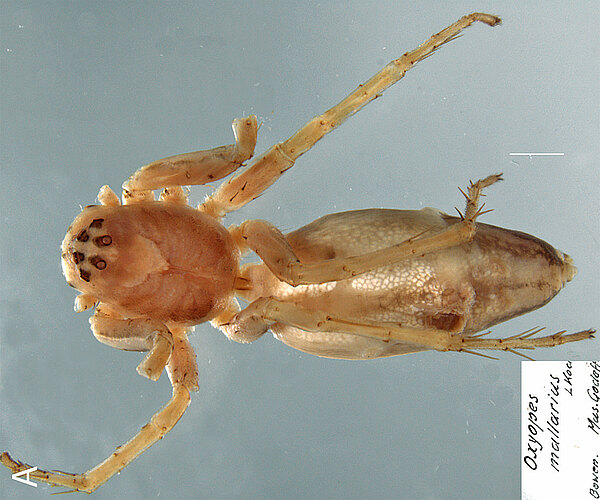Grinding Lynx Spider Oxyopes molarius L. Koch, 1878
Fauna Portal species: 8303Diagnosis
(after Baehr et al. 2017): Females of Oxyopes molarius are similar to those of O. amoenus but can be distinguished from that by the longer lateral lobes in v-shaped position and the coils are mostly hidden behind the T-shaped scapus.
(after Whitehouse & Grimshaw 2007): Distinguishing between the palps of O. gracilipes and that of the other two species is relatively easy; O. gracilipes has a small, triangular cymbial apophysis (paracymbium) instead of the large, distinctively hooked cymbial apophysis of O. amoenus and O. molarius. However, distinguishing between males of O. molarius and O. amonenus is difficult. The only differences we found between the palps of these two species were the shape of the cymbium hook (the hook is longer and more curved in O. molarius) and the shape of a second cymbial apophysis, which is a small mound in O. molarius and bears a thickened proximal border resembling a hook in O. amoenus.
Status
- native
Linnean Lectotype(s)
Australia
- New South Wales
- Queensland
- South Australia
Fauna Portal Records
The map shows all records that have been verified as part of the Fauna Portal project and may not represent the true distribution of a species. Specifically, for described species, check the link to the Atlas of Living Australia on this page for potential wider distributions. Fauna Portal Reference specimens and Linnean types are shown in red. If you identified a specimen that exceeds the distribution of an undescribed species as illustrated here, please contact the Fauna Portal team who can assist with the lodgement of the specimen in a public institution and display on the map.
Similar Species
Publications
Baehr BC, Harms D, Dupérré N, Raven RJ (2017): The Australian Lynx Spiders (Araneae, Oxyopidae, Oxyopes) of the Godeffroy Collection, including the description of a new species. Evolutionary Systematics. 1: 11 - 37
Whitehouse MEA, Grimshaw JF (2007): Distinguishing between lynx spiders (Araneae: Oxyopidae) relevant to IPM in cotton in the Namoi Valley, New South Wales. Australian Entomologist. 34: 97 - 106
Araneae (Spiders)
- Actinopodidae
- Anamidae
- Araneae fam. indet.
- Araneidae
- Archaeidae
- Argyronetidae
- Arkyidae
- Barychelidae
- Cheiracanthiidae
- Clubionidae
- Corinnidae
- Cycloctenidae
- Deinopidae
- Desidae
- Dictynidae
- Filistatidae
- Gnaphosidae
- Halonoproctidae
- Hersiliidae
- Idiopidae
- Lamponidae
- Linyphiidae
- Lycosidae
- Mimetidae
- Miturgidae
- Mysmenidae
- Nicodamidae
- Oecobiidae
- Oonopidae
- Oxyopidae
- Philodromidae
- Pholcidae
- Pisauridae
- Prodidomidae
- Salticidae
- Scytodidae
- Segestriidae
- Selenopidae
- Sparassidae
- Symphytognathidae
- Tetrablemmidae
- Tetragnathidae
- Theridiidae
- Thomisidae
- Trachelidae
- Trachycosmidae
- Trochanteriidae
- Uloboridae
- Zodariidae
- Zoropsidae
All classes
- Arachnida
- Crustacea
- Entognatha
- Gastropoda
- Insecta
- Orthoptera - Caelifera (Grasshoppers)
- Hymenoptera excl. Formicidae (bees and wasps)
- Blattodea s. str. (Cockroaches)
- Coleoptera (Beetles)
- Dermaptera (earwigs)
- Diptera (flies, mosquitos)
- Entomobryomorpha (slender springtails)
- Hemiptera - Heteroptera (True Bugs)
- Hemiptera - Sternorrhyncha (aphids, scales etc.)
- Hemiptera - Auchenorrhyncha (cicadas, planthoppers)
- Hymenoptera - Formicidae (Ants)
- Trichoptera (Caddisflies)
- Zygentoma (silverfish)
- Myriapoda

